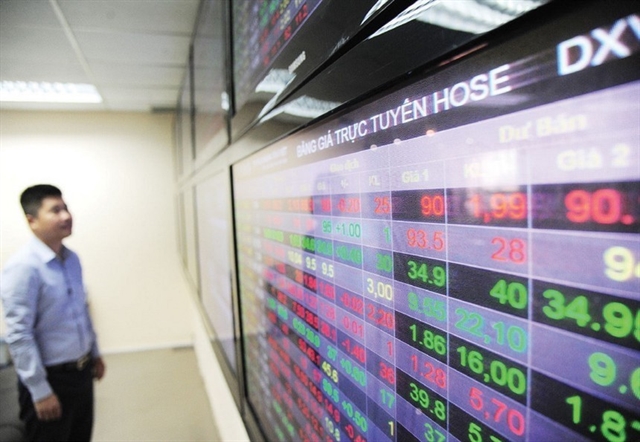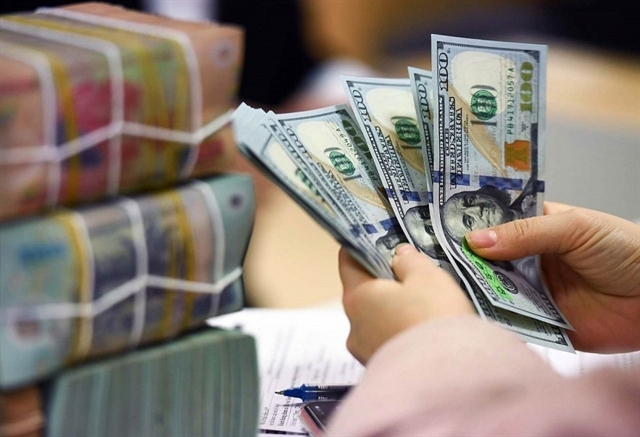 Economy
Economy
.jpg)
 |
| The total net profit from the foreign exchange trading segment of 29 banks in the first three quarters of 2024 reached more than VNĐ19.62 trillion, up 7 per cent over the same period last year. Photo cafef.vn |
HÀ NỘI — Net profits from the foreign exchange trading segment of many banks have gained positive results thanks to a strong USD/VNĐ exchange rate fluctuations this year.
According to banks’ financial statements, the total net profit from the foreign exchange trading segment of 29 banks in the first three quarters of 2024 reached more than VNĐ19.62 trillion, up 7 per cent over the same period last year.
State-owned BIDV continued to maintain its leading position in terms of value in the business segment, with a net profit of more than VNĐ3.92 trillion, up 25 per cent over the same period last year.
In the group of private banks, MB topped the list with a net profit of nearly VNĐ1.52 trillion, representing an impressive growth of 65 per cent.
Techcombank also made its mark with a net profit of nearly VNĐ1.02 trillion in the first three quarters of this year, while the bank reported a loss of VNĐ117 billion in the same period last year.
Similar to Techcombank, VPBank also recorded a sharp increase in net profit from the foreign exchange trading segment, with more than VNĐ594 billion. This figure was not so large compared to the whole banking industry, but it was a significant growth rate compared to VPBank’s loss of more than VNĐ600 billion in the same period last year.
Other banks also made large profits from this business segment, such as MSB with VNĐ846 billion, Sacombank with VNĐ831 billion, ACB with VNĐ827 billion, HDBank with VNĐ609 billion and SeABank with VNĐ563 billion.
According to the banks’ financial reports, foreign exchange trading mainly relies on two main sources of revenue - spot foreign exchange trading and currency derivatives. This business segment depends heavily on fluctuations in the US dollar and other foreign currency exchange rates in the domestic market.
October 2024 witnessed a sharp increase in the USD/VNĐ exchange rate, with a 4.2 per cent depreciation of the Vietnamese đồng against the dollar compared to the beginning of this year. Notably, the đồng in October 2024 alone devalued by up to 1.2 per cent compared to September 2024. According to Mirae Asset, most of this depreciation originated from strong fluctuations in the dollar index (DXY), which increased rapidly due to better-than-expected US economic data.
This pressure has significantly affected the đồng and created a burden on the Vietnamese economy, especially when Việt Nam’s foreign exchange reserves have decreased after the State Bank of Vietnam (SBV) had to sell a significant amount of the US dollar to stabilise the forex market. Việt Nam's foreign exchange reserves are currently only at 2.4 months of imports - lower than the 3-month of import level recommended by the International Monetary Fund.
Analysts from Mirae Asset Securities Company forecast that the USD/VNĐ exchange rate may continue to remain high or increase further if global factors, especially from the US, do not cool down. The US Federal Reserve (Fed)'s policy of maintaining high interest rates to control inflation may continue to boost the dollar, putting great pressure on other currencies including the đồng. Therefore, the central bank's lowering of interest rates will face many challenges, as this may increase pressure on the exchange rate.
To minimise the foreign exchange pressure, Mirae Asset suggests that the SBV seek additional measures to stabilise the liquidity of the market, without reducing the country’s foreign exchange reserves. The solutions include strengthening cooperation with major trading partners to diversify foreign currency sources, considering adjusting interest rate policies to reduce the impact of exchange rates on inflation and considering policies to support local exporters to increase foreign currency-denomivated revenue collected or reduce unnecessary costs of imports to ease pressure on domestic enterprises. — VNS
.jpg)



